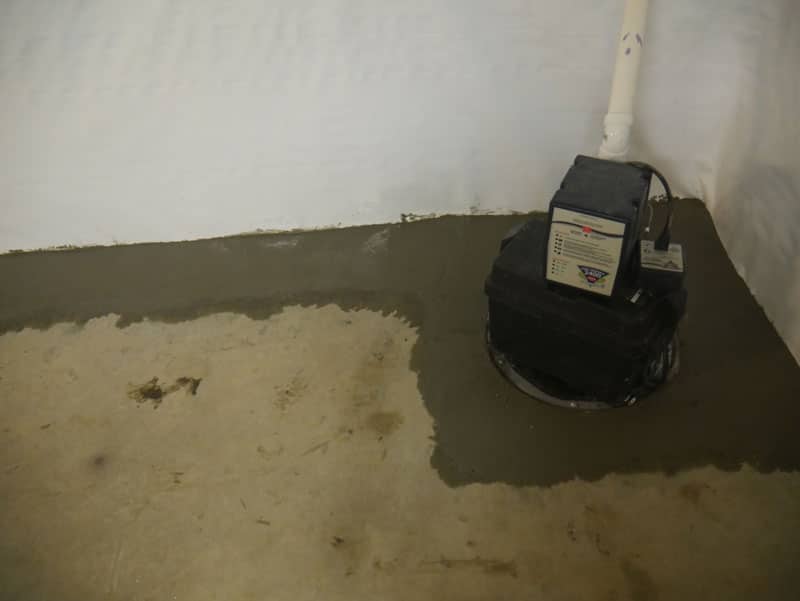
A sump pump is a core component of your waterproofing system, necessary to protect your home from flooding. A sump pump’s responsibility is to pump out water in your basement or crawl space and evacuate it through an appropriate drainage system, keeping your home safe and dry.
There are various types of sump pumps, and the right one for your home depends on a number of factors. If your basement frequently experiences flooding or standing water, it might be time to have one of these five types of sump pumps installed.
5 Different Types of Sump Pumps
A sump pump automatically detects water levels in the basement of your home as it collects in a sump pump. When the water rises above a safe level, the sump pump starts pumping out water through a discharge line. The water is then evacuated out and away from your home. Below is a detailed overview of five different types of sump pumps you can install in your basement or crawl space.
1. Submersible Sump Pumps
A submersible sump pump is installed inside the sump basin or pit and operates underwater. It is enclosed in a watertight casing and equipped with a sensor that detects water levels. A submersible sump pump has an impeller that ejects excess water from the sump pit via a drainage pipe attached to the pit.
The primary advantage of a submersible sump pump is that it uses direct pressure to move water out of the discharge pipe instead of suction. This method enables it to move water over a greater distance. Also, a submersible sump pump does not need to be primed to operate. It starts working the moment it’s installed. As a result, its motors are burnout-safe and are able to move large amounts of water.
2. Pedestal Sump Pumps
Unlike a submersible pump, a pedestal sump pump is installed above the sump pit’s water line. It sits on a pedestal that keeps it stable above the water. It also has a float switch that triggers the motor to kick in when water reaches a certain height. The motor pumps out water and evacuates it away from your home through a drain pipe.
One unique advantage of a pedestal sump pump is that it can move large amounts of water without developing problems. It’s ideal for areas that receive a lot of rainfall or snowfall and are prone to flooding.
3. Battery Backup Sump Pumps
Battery backup sump pumps operate similarly to other sump pumps; once water rises, the float switch activates the pump, and the motor kicks in. The only difference is that a battery backup sump pump keeps operating even if the power goes out.
One unique advantage of a battery backup sump pump is that the loss of electricity, which is a common occurrence during storms and floods, won’t hinder the pump’s performance. A battery backup sump pump is ideal for areas that often experience power outages during rainfalls.
4. Combination Sump Pumps
A combination sump pump is a popular type of pump that combines the primary pump and battery backup pump in one. It has all the salient features of a traditional sump pump with an added layer for protection. It comes with a sump pump, a battery case, a controller, and a backup pump if the primary pump fails. The battery supplies power to the backup pump if the primary one fails.
5. Water-Powered Sump Pumps
Water-powered sump pumps are less popular than other types of pumps. However, they are unique in the way they function. Water-powered sump pumps use water pressure from a municipal water source to create a vacuum and suck water from the sump pit. Water-powered sump pumps do not depend on electricity to operate, which means they will keep working even during power outages.
These pumps are generally used as a backup for other traditional sump pumps. A water-powered sump pump does not have a motor, which is why it doesn’t require much maintenance and lasts longer than other pumps. Although they are very convenient, the water pressure must be high enough for the pump to do its job efficiently. If the water pressure is low, it will compromise the pump’s performance and efficiency.
How to Choose the Right Sump Pump
Choosing the right pump depends on a wide range of factors. Here are some of the factors you should consider before selecting a sump pump for your home:
1. Switch
There are four main types of switches a sump pump can have: a tethered float switch, a diaphragm switch, a vertical float switch, and an electronic switch. All of these switches turn on the pump when the water in the sump pit reaches a certain level.
2. Horsepower
Common motor sizes in sump pumps include 1/4 HP, 1/3 HP, 1/2 HP, 3/4 HP, and 1 HP. What horsepower really determines is how many gallons of water per hour a sump pump can pump out. If your sump pump runs constantly, regardless of weather conditions or time of year, you need a more powerful pump. Have your basement inspected by professional waterproofing experts to get expert advice about how much power your sump pump should have.
3. Housing
Most pumps have a plastic or cast-metal housing. Stainless steel is used in more expensive models. If you are buying a pedestal pump, you need a sturdier exterior to protect the pump. Depending on your basement and your budget, choose the sump pump housing that works for you.
4. Maintenance
All sump pumps have different maintenance requirements. Pedestal sump pumps generally need more maintenance since they are exposed to the air and can become corroded. Before installing a sump pump, consider the space available in your basement and how frequently you are willing to maintain a pump.
Get Professional Help for Sump Pump Installation
There are various types of sump pumps, each with a different set of features and maintenance requirements. The right sump pump for your home depends on weather conditions in your area and your basement’s dimensions. The easy way to make this decision is with professional help.
The experts at KC Waterproofing and Foundation Repair can inspect your basement and recommend a suitable sump pump to keep your home safe and dry. Our sump pump installation provides safe, easy access to the pump for maintenance needs.
Contact us for professional sump pump installation.










